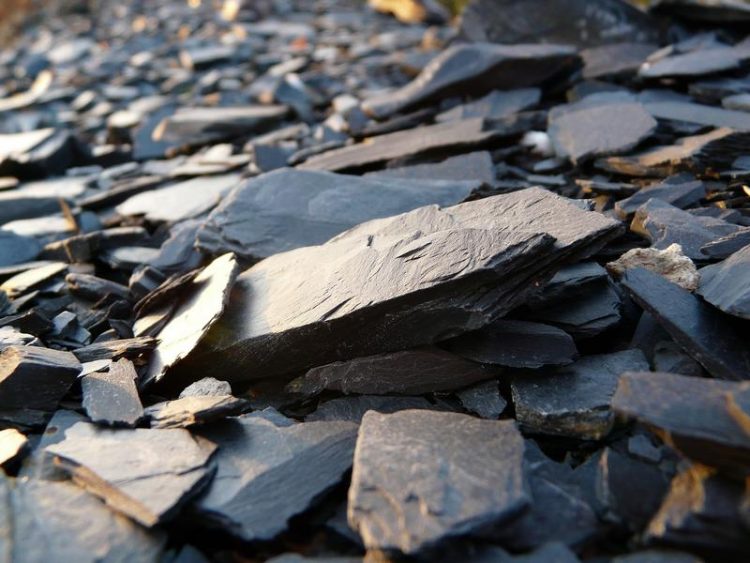It gave its name to several mountain chains in Europe: Slate is ‘Rock of the Year 2019’ in Germany

Schieferpark Lehesten, Thuringia Susen Reuter
Today, slates, i.e. slate blackboards, and slate pencils, which were used by generations of schoolchildren up to the last century, have usually survived merely in museums (e.g., Deutsches Schiefermuseum – German Slate Museum – in Mayen/Eifel, or Schiefermuseum/Slate Museum in Ludwigsstadt, Upper Franconia).
But as elegant and durable roofing and cladding material or as cut stones to be used for staircases or in gardening slate is still highly appreciated.
Slates are rocks which emerge from clayey sediments through metamorphism (under high pressure and/or high temperature), which is sometimes accompanied by folding.
Slates show very good to excellent foliation along their slate surfaces. In contrast, non-metamorphic and usually finely-grained sediment rocks with a foliation similar to that of slate, which, however, is here due to alternating sediment layers, are called “shale”.
Slate had already been used for roofing in Ancient Rome. However, the golden age of roof slate was the Middle Ages and the Early Modern Age, when slate became so important that major mountain ridges were given its name, such as Rheinisches Schiefergebirge (Rhenish Slate Mountains) and Thüringer Schiefergebirge (Thuringia Slate Mountains).
Germany’s slate resources go back to the Paleozoic, usually to the Devonian and Carboniferous periods, which means that the slates are more than 300 million years old.
Still today, there are slate quarries and mines in Germany: in Geroldsgrün in Upper Franconia, where Lotharheiler slate is still being mined, in the Hunsrück Mountains (Altlay Slate Quarry), in the Sauerland Mountains (combine mine Magog-Gomer-Bierkeller, the slate of which is marketed as “Fredeburg” slate), and in Theuma near Plauen (Vogtland, Saxony, sold as “Theumaer Fruchtschiefer”). Despite high demand the Katzenberg slate mine near Mayen/Eifel will be closed this year, as the mining there is no longer profitable due to problems with the geology of the deposit.
Apart from roofing, slate is excellent for stone floorings and walls; it combines both heat and cold resistance with durability and beauty.
Slate, today, can be watched and experienced in geoparks and museums. A well-known slate location in Germany is Lehesten in Thuringia where the former quarry has been transformed into a geoscientific adventure park.
Another world-famous slate sight in Germany is the Loreley rock near St. Goarshausen in the Middle Rhine Valley, which is also a UNESCO world heritage site and best known from the legend and the poem of the “fair Loreley”.
The slate will be 'baptized' as 'rock of the year' in April this year, sometime around “Earth Day“ (22 April), in an active slate quarry, probably in the Eifel area. The slate year will be accompanied by publications on slate and geoscientific as well as artistic events featuring slate all over Germany.
Dr. Christof Ellger, GeoUnion, Christof.Ellger@geo-union.de
Dr. Manuel Lapp, Sächsisches Landesamt für Umwelt, Landwirtschaft und Geologie, manuel.lapp@smul.sachsen.de
Media Contact
More Information:
http://www.geo-union.deAll latest news from the category: Earth Sciences
Earth Sciences (also referred to as Geosciences), which deals with basic issues surrounding our planet, plays a vital role in the area of energy and raw materials supply.
Earth Sciences comprises subjects such as geology, geography, geological informatics, paleontology, mineralogy, petrography, crystallography, geophysics, geodesy, glaciology, cartography, photogrammetry, meteorology and seismology, early-warning systems, earthquake research and polar research.
Newest articles

Nerve cells of blind mice retain their visual function
Nerve cells in the retina were analysed at TU Wien (Vienna) using microelectrodes. They show astonishingly stable behavior – good news for retina implants. The retina is often referred to…

State-wide center for quantum science
Karlsruhe Institute of Technology joins IQST as a new partner. The mission of IQST is to further our understanding of nature and develop innovative technologies based on quantum science by…

Newly designed nanomaterial
…shows promise as antimicrobial agent. Rice scientists develop nanocrystals that kill bacteria under visible light. Newly developed halide perovskite nanocrystals (HPNCs) show potential as antimicrobial agents that are stable, effective…



